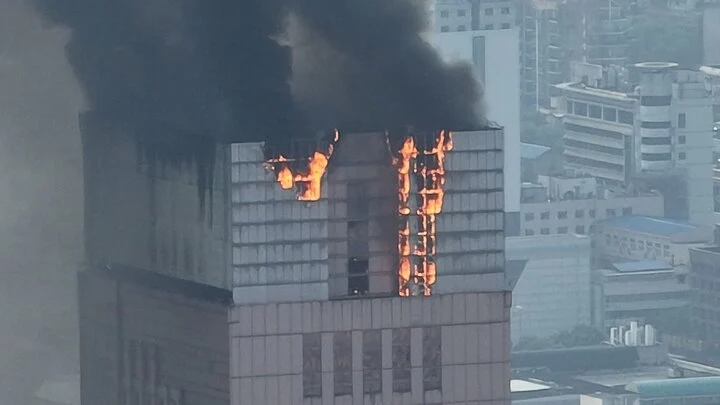With high-rise apartments, fire incidents are the most concerning due to the complex structure of these buildings and the high population density, which can lead to severe casualties in the event of a blaze.
High-rise fires are typically intense, spread rapidly, are challenging to extinguish, and pose a significant threat to life. So, in the unfortunate event of a major fire in a high-rise building, should one run up or down to escape and ensure their safety?
Should you run up or down during a high-rise fire?
According to guidelines from fire safety authorities, when a fire is detected, individuals must remain calm and quickly seek solutions to extinguish the blaze using fire extinguishers, CO2 canisters, sand, blankets, water, etc. If the fire is too large to be controlled, one must immediately consider an escape plan.
Promptly press the building’s alarm bell, shout to alert others about the fire, and call 114 to inform the Firefighting Police force.

In the event of a fire in a high-rise building, should you run up or down? (Source: CNN)
When a fire occurs in a high-rise, whether to run up or down depends on the fire’s location. If the fire is not in your room or on your floor, the first thing to do is to identify the source of the fire and smoke. If the smoke is coming from above or is on your floor, quickly move towards the exit and escape downwards, avoiding the use of elevators.
However, if the fire originates from a lower floor, especially the first floor, and the flames are uncontrollable, the situation becomes more complex. The fire will inadvertently block the escape route through the stairwell and the building’s main entrance.
Smoke will rise rapidly in such cases. Therefore, residents on lower floors, within a height of 3.5 meters, can attempt to escape through windows or balconies if safe conditions are met, such as having a rope to climb down.
If it is not safe to do so, instead of jumping, consider moving upwards to higher floors or the rooftop, seeking a safe area, and closing doors to isolate yourself from the fire. Ideally, look for areas with windows or balconies that provide ventilation and a fresh oxygen supply.
If there are gaps under the door of your room, use damp towels or blankets to block them and prevent smoke from entering.
In summary, during a fire in a high-rise building, if the fire is on a higher floor, escape downwards. If the fire is on a lower floor and the escape route downwards is blocked, head upwards towards the rooftop as soon as possible. If you encounter fire, smoke, or a blocked path while heading upwards, be decisive and change your escape route to a safe exit on another floor.
Escape strategies during a high-rise fire
Here are some basic skills to help you escape in the event of a fire in a high-rise building.
Stay Calm and Extinguish the Fire
The primary factor in surviving a fire is maintaining calmness and quickly implementing escape methods. When the fire is small, try to put it out using fire extinguishers, CO2 canisters, sand, blankets, water, or whatever else is readily available.
If the fire is too large to control, quickly find an escape route. Shout to alert others so they can escape with you, and immediately dial 114 for assistance.
Identify a Safe Escape Route
If the fire did not originate from your room or floor, clearly identify the fire’s location and the smoke’s direction to plan the quickest escape route for yourself and your family. As mentioned, if the fire is on an upper floor, head downwards. Conversely, if the fire is on a lower floor, move upwards towards the rooftop.
Never hide in a room and close the door tightly, as smoke spreads rapidly, and inhaling too much smoke can lead to unconsciousness and death.
If the fire blocks your path in the hallway, your only option is to move to a more open and ventilated space, such as a balcony. Remember to close the balcony door and block the smoke with wet towels or blankets.
Do Not Use the Elevator
During a fire, never use the elevator as an escape route. The power may be cut off, and you could become trapped inside. Instead, use the stairwell and follow the “EXIT” signs to safety. Also, inform your neighbors in nearby apartments about the fire.
Find a Hiding Place to Avoid Smoke
Most fire-related deaths are caused by smoke inhalation. To prevent this, use a wet towel or cloth to cover your mouth and nose, filtering the air you breathe. Stay away from enclosed spaces and areas with potential explosion hazards, such as gas cylinders, refrigerators, and air conditioners.
To avoid smoke inhalation, you can create a temporary shelter by wetting a mattress and placing it at a 45-degree angle against the balcony wall. The smoke will slide along the mattress and rise upwards. This is one of the essential fire escape skills you should know.
Note when moving: When moving, stay low and close to the wall. When opening doors, check the temperature to avoid being burned by the fire. If the temperature is too high, find an alternative escape route.
According to VTC news

































